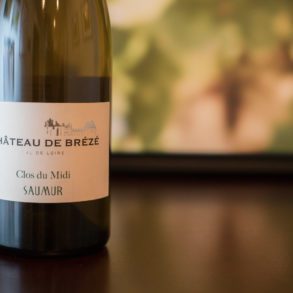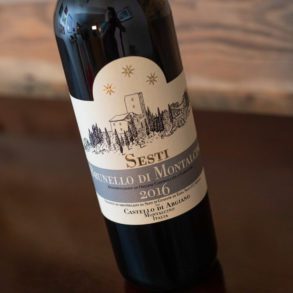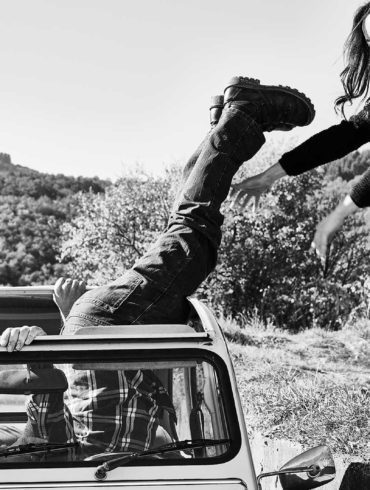Organic & Biodynamic Wines
We use these icons to indicate whether a wine is organic (leaf) or biodynamic (moon). When applied to a producer on this site, it means that more than half of their wines are organic or biodynamic. Lastly, we color-code them green to indicate certification from a third-party (for example the EU or USDA for organic, or Demeter or Biodyvin for biodynamic).
Of course, all of this is the most slippery slope in winemaking. Should producers get credit for merely "practicing" these techniques without certification? And are they actually environmentally friendly? We'll do our best to explain below.
 Maeli's organic vineyards in Colli Euganei, Veneto, Italy. ©Kevin Day/Opening a Bottle
Maeli's organic vineyards in Colli Euganei, Veneto, Italy. ©Kevin Day/Opening a Bottle A biodynamic vineyard in Alsace, France. ©Kevin Day/Opening a Bottle
A biodynamic vineyard in Alsace, France. ©Kevin Day/Opening a BottleWhy Organic Matters
There are several reasons for winemakers to "go organic." There are also legit reasons for wine drinkers to seek out these wines.
For me, the evidence is personal. I've walked through organic vineyards, as well as conventionally farmed ones. The former were teeming with life. They seemed like enjoyable places to work. The latter? Not so much.
That said, the devil is truly in the details. If a winery is not organic, that does not necessarily mean their vineyards are the scene of chemical warfare, as some natural wine proponents like to portray it. Secondly, producers are allowed to apply copper sulfate to combat such maladies as mildew and rot, and retain their organic standing. This naturally occurring element is not only toxic, but it doesn't disappear from the soil unless its washed away by rain. And where does it end up then? In streams, rivers, the ocean or in aquifers. So organic isn't necessarily "clean." There are alternatives on this front, such as using milk instead of copper sulfate to guard against mildew, and conscientious organic winemakers are increasingly embracing these avenues.
I assign the organic icon to both certified organic winemakers and the far mushier term "practicing" organic winemakers. If the icon is colored green, the producer went the extra lengths to be certified as such, which to me is an added measure of transparency worth recognizing. If its red, that means there is gray area in how much is organic. They can claim to be 100% organic, but without more editorial resources, without a full year to witness their operation with my own eyes, without — in short — certification, I have to take their word for it.
Even if I have visited the estate and everything seems organic, much of this is based on trust. Looks can be deceiving, so it stays red, just like the other icons. (Greenwashing is just as prevalent in wine as it is elsewhere).
Now, why not recognize only certified organic? Because its costly and bureaucratic to get certified. Some producers can easily afford the certification process, but for others on a razor-thin margin, its an expense that can deplete their resources. Organic viticulture is also easier in some places. Where it is difficult to enact (usually because of humidity and rain), being about to apply certain non-organic treatments in certain doses might be the ripcord a winery needs to survive a vintage (see my notes on copper sulfate above). The choice is easier for some than others.
By and large, most practicing organic winemakers that I've encountered are truly following through on this promise, and the health of their vineyards would suggests as such.
Why Biodynamic Matters
Biodynamic is more intensive, and also more controversial. Following the tenants of philosopher Rudolf Steiner, biodynamic farming, in short, seeks to improve the overall health of the vineyard as an ecosystem by increasing microbial life in the soil, allowing and managing cover crops for biodiversity, and timing certain actions with the phases of the moon (thus, the icon).
What could be controversial about that? Well, the devil is in the details. Certain biodynamic tenants could still use more support from scientific study, and some feel that we should be leery of the absolutism the movement sometimes engenders.
That said, if an approach works for a winemaker and their particular vineyard and winery, and they have evidence to suggest its the right approach for what they want to accomplish, I am all ears. The jury is still out for me on biodynamics, but I do find aspects of the practice compelling, such as treating the vineyard as an interconnected part of the ecosystem, as well as timing certain procedures with plant cycles. I'll also say that many of my favorite wines happen to be biodynamic. What I'll likely never know is if they are my favorite because they are biodynamic, or just because they are meticulously made wines.
As with the organic icon, if the biodynamic moon is colored dark green, that means they've gone the extra mile for biodynamic certification through Demeter or Biodyvin.
As you can see, I am not dogmatic on this topic, but I do want to celebrate the commitment to reducing the use of chemicals, or at the very least, limiting their application. There are other certifications that I hope catch on as well, most notably certifying wineries for operating with biodiversity in mind. This will be an evolving subject matter for sure.





















